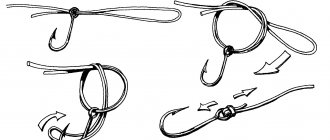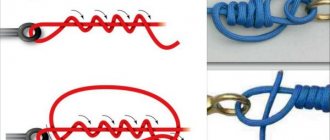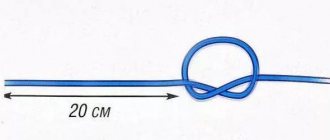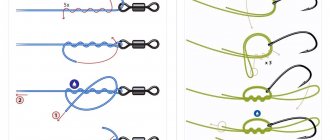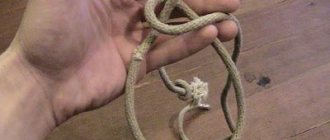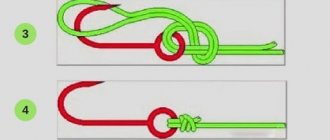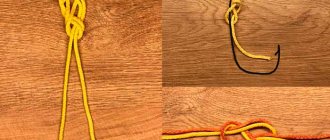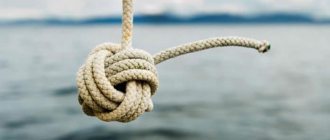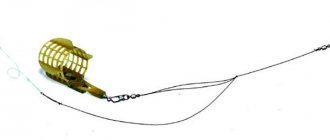Rules for reliable connection of windbreak and fishing line
When connecting a fishing line to a swivel, you should adhere to the following basic rules:
- You should not use swivels that have various defects on their rings in the form of burrs , sharp spikes or splits. They will interfere with the integrity of the line and its rate of passage through the swivel, eventually causing the line to break.
- The cross-sectional shape of the fishing line should be round and not flat, since when tying a knot, fishing lines with a flat cross-section twist more, which leads to a deterioration in the strength of the future knot.
- Before tightening the knot, you need to moisten the line with water. If you tighten a fishing line that has not been previously wetted with water, the fishing line will overheat and greatly lose its elastic and strong properties, which should hold the entire knot.
- The thickness of the fishing line used (its diameter) . When selecting fishing lines for tying knots, you need to know that the larger the diameter of the fishing line, the stronger and more reliable the future knot will be, since they are not as susceptible to ruptures, stretching and various deformations, unlike thin fishing lines.
- The more complex the knot, the greater the impact it has on the structure of the fishing line. Therefore, for fishing lines with a medium or thin diameter, simple types of knots should be selected.
Knots for attaching the swivel to monofilament fishing line
The first knot, which is most often used to attach a swivel to a monofilament line, is the Grinner .
Its strength in practice is eighty-five percent, which is a good result. In addition, this unit has the following advantages of its use:
- has very good load capacity;
- in addition to the swivel, they can be used to tie hooks and sinkers (carp);
- shows long-term service;
- easy to perform;
- Doesn't take long to tie.
The Grinner knot is tied in this way:
- First you need to thread the tip of the monofilament line into the swivel ring. The total length of the fishing line used must be at least eighteen centimeters.
- Take the other end of the fishing line and fold it in half to make a loop.
- Pinch the area where the two ends of the lines intersect with your fingers and wrap the line folded in half with several turns. There must be at least six windings. If there are fewer turns, the knot will be too weak.
- Pull the other end of the fishing line into a larger loop and begin to slowly tighten the knot. Before doing this, you need to moisten it with a small amount of water.
- When pulling the line through the main loop, move the knot towards the swivel loop.
- After stepping back two millimeters, carefully cut off the excess fishing line at its tip.
The second knot, which is used to tie the swivel to the monofilament line, is called "Homer" . Its advantage is that its strength in practice is ninety-eight percent, which indicates its incredible reliability when tied correctly. For this reason, this knot is very popular among many fishermen.
The Homer knot is knitted in the following sequence:
- Measure out fifteen centimeters of fishing line.
- Pull one end of the line into the eye of the swivel.
- Wrap the working tip of the fishing line twice along the main fishing line and pull it into the resulting loop.
- Do not tighten the resulting knot, but hold it with your hand, while winding the other end of the fishing line around the main fishing line six to eight times.
- Pull the other end of the fishing line into this loose loop.
- Tighten the main and working lines at the same time, after wetting them.
- Push the resulting knot towards the swivel ring so that it rests directly on the eye of the fastener.
- After retreating two millimeters, cut off the excess fishing line.
To the fishing line
First of all, I want to consider installation options with regular fishing line (which is the most popular among fishermen). Fishermen identify two main units for such needs. We have already described the first node above, and it is called Grinner. They can be used to tie not only fishing line
.
Technique for tying a swivel to a fishing line using a Grinner knot
happens as follows:
- Pass the end of the line through the eye of the swivel and pull the edge about 15 centimeters;
- Now you need to lay the free end over the fishing line to make a loop;
- Now take the working end and wrap it around the fishing line about 5-7 times and insert it into the first loop;
- You will get another loop, so you need to stretch the free end of the fishing line into it;
- Wet the line with water and tighten the knot;
Do not cut off the entire line, leave a free end about 1.5 millimeters long
so that the knot does not come undone.
Also, domestic fishermen quite often use the Homer knot
, if a connection with a regular fishing line is required. Its load capacity and strength are not inferior to those described above. Let's look at the diagram and step-by-step installation instructions:
- We take the main fishing line and pull it through the swivel ring, leaving about 15 centimeters free;
- We wrap the remaining end around the main fishing line to form a loop (see picture);
- Now take the end of the fishing line and pull it through the resulting loop;
- Now you need to take the fishing line itself and wrap it around its axis 4-6 times;
- Thread the end of the fishing line into the resulting loop;
- Moisten and tighten the knot.
When you tighten the knot, be sure to pull on two lines at the same time. Try to move the knot as close to the eye of the swivel as possible.
These were the two most common, durable and simple mounting options for regular fishing line. Now, I think it's time to move on to something else. Namely, consider how to tie a swivel to a braided fishing line. Let's get started.
Knots for attaching a swivel to a braided line
To tie a swivel to a braided line, the following types of knots are used:
Knot "Palomar". It is considered the simplest fishing knot and can also be used on monofilament fishing line. The “Palomar” is tied in this way:
- The tip of the fishing line must be folded in half so that the length of the resulting folded segment is at least ten centimeters.
- Pull the folded end of the fishing line through the ring of the swivel.
- Make a regular knot over the swivel. There is no need to tighten it. The swivel should appear to be inside the loop.
- If done correctly, you should have a loop coming out, with another loop coming out on one side, and the swivel located under the first large loop.
- Throw a smaller loop onto the swivel.
- Pull the swivel through the large loop.
- Moisten the knot and tighten it.
- Trim off excess line.
The “Clinch Reinforced” knot has a strength of more than seventy-eight percent. You should know that it should not be used for tying hooks with a small eye. The main advantage of such a unit is its simplicity of execution and reliability.
It fits like this:
- Fold the fishing line in half so that the resulting folded segment is at least fifteen centimeters long.
- Pull the resulting loop into the eye of the swivel.
- Pull this line so that the unused end of the loop is nine centimeters long.
- Make five turns of this loop tip around the main line.
- Pull the tip of the fishing line into the loop formed and pull it slightly.
- Next you need to pull the main line so that the working tip of the line does not fall out of the loop.
- Pull the main line, and at the same time pull the other end of the line from time to time. Moisten it with water and tighten completely.
- Trim the excess line, leaving only two millimeters near the knot.
To the braid
There are several ways to tie a swivel to braid. But the simplest and most reliable knot is called Palomar
.
It can also be used to tie a regular fishing line
, but it still shows its qualities better on a braided cord. The execution sequence of the node is as follows:
- Take the free end of the main fishing line, about 10 centimeters long, and fold it in half;
- Now pull the double loop into the eye of the carabiner (as in the diagram);
- Tie a regular knot, but do not tighten it;
- Place the swivel at the bottom of the large eyelet;
- Now put a small one on top of it (see the diagram so as not to get confused);
- Pull the swivel through the large loop;
- That's it, all that remains is to tighten the knot.
Also an excellent knot for such purposes is the reinforced Clinch knot
. But it has a significant drawback - it is not suitable for tying on thick fishing line and is used only on medium-diameter ears made of thin wire. The node execution sequence is as follows:
- The end of the fishing line must be threaded through the eye and pulled back by about 15 centimeters;
- Fold the fishing line in half;
- Wind the free end around the main line 5-10 times;
- Now pull it through the formed loop;
- And again pull the free end into the large loop obtained as a result of the action in step 4;
- Wet the knot and tighten it.
It is very important when tightening to ensure that the free end does not fall out of the main loop.
Knots for attaching the swivel to fluorocarbon fishing line
A Rapala knot is used to tie the swivel to fluorocarbon fishing line. It is very similar to the Homer knot, but the tying process is a little more difficult. The Rapala knot is the best solution when you need to make a loose loop. In addition, it can be used to tie oscillating spinners, which have a bad “game” at other nodes.
The Rapala knot is tied in the following sequence:
- Make a regular knot on the fishing line without tightening it.
- Pull one end of the fishing line into the eye of the swivel and pass it into the first knot.
- Wrap six turns around the main line.
- Turn the tip of the fishing line again and thread it through the knot so that a loop is made.
- Unfold the tip of the fishing line and insert it into the last loop.
- Moisten the knot and tighten it tightly.
- Trim off excess line.
How to tie to fluorocarbon line
Fluorocarbon differs in its qualities from other cord bases in its fragility. In addition, the material is demanding for optimal clamping of the knitting, since under-pressed knots are prone, as a result of increased dynamics, to relax and spontaneously untie. Fluorocarbon, like fishing line, is susceptible to extreme friction and is prone to burnout in these cases.
Rapala knot
Rapala knot helps to optimally tie the fishing line to the swivel . It is this element of the ligament that satisfies all the conditions when an angler uses a fluorocarbon cord or leash. Installation helps to avoid friction in the swivel ring, since the free loop element of the knot constantly changes the points of contact between the components of the connection.
The design of the knot allows you to tighten the binding without the possibility of subsequent relaxation of the connection. Well, and on top of everything else, the Rapala knot slightly and not critically breaks the structure of the scaffolding material, which, based on its fragility, is quite an important component. Just like monofilament, this type of material requires wetting when tightening the mounting loop to avoid burnout.
Particularly scrupulous fishermen additionally apply a drop of quick-setting glue to the twist of the knot, which increases reliability. As can be seen from the listed requirements for the material, correctly tying a swivel to a fluorocarbon fishing line using another type of knot is more problematic. An alternative to this connection can only be mechanical compression of the loop with a tube, which has a slight effect when fishing using leader material, but has a much stronger effect when using spinning rods, which already deteriorates fishing conditions.
Universal knots for attaching a swivel
The most well-known and universal units for attaching swivels are:
Clinch knot . It must be used on monofilament fishing line, the diameter of which will not be larger than 0.5 millimeters.
If you use thicker fishing line, it will be difficult to tighten the knot tightly. This type of node has the following advantages of its application:
- easy to knit;
- has good load capacity;
- When done correctly it lasts a long time.
The “Clinch” is knitted this way:
- Measure a piece of monofilament fishing line with a length of twenty-five to thirty centimeters.
- Thread the line into the eye of the swivel.
- Turn the eye of the swivel toward your hand eight times so that there are twists on the main line.
- Pull the other end of the fishing line into the first loop near the eye of the swivel.
- Moisten the knot with water and tighten tightly.
- Cut off excess line from the knot.
In addition, such a knot can be made even stronger if, after the fourth turn, you once again pull the fishing line into the resulting loop.
The second universal knot for tying a swivel is called “ Figure Eight”. It has the following features of its use:
- the fishing line for this knot does not bend or deform, so it can be reused;
- "eight" is easily untied if necessary;
- the principle of tying is very simple and even a novice fisherman can handle such a knot;
- the knot has good strength.
The Figure Eight is tied in this way:
- First you need to measure twenty centimeters of fishing line.
- Fold the fishing line in half and make a simple loop.
- Place both ends of the fishing line on its middle so that they go under one another, forming a figure eight.
- Moisten the knot and tighten tightly.
- Trim off excess line.
Blitz tips
- Be sure to wet the line before each time you tighten the knot, as this is very important.
- Those fishermen who do not yet have residual experience in tying fishing knots are recommended to first practice on twine or textile cord. With such materials it will be much easier to follow and remember the algorithm for tying one or another type of knot.
- There is no need to rush when tying knots, since quick and sharp jerks of the fishing line significantly impair the reliability of the future knot.
- Small tweezers (for manicure) are considered the best device for safe and convenient cutting of fishing line. The use of a knife in this matter is extremely undesirable, since it can damage the assembly.
- If you are unsure of the reliability of the knot you have tied, then you should not take risks and use it in practice. It's better to re-tie the knot.
- Reliable knots require a lot of training and perseverance from the angler, so the latter must practice often, and only then will the knot be obtained according to all the rules.
